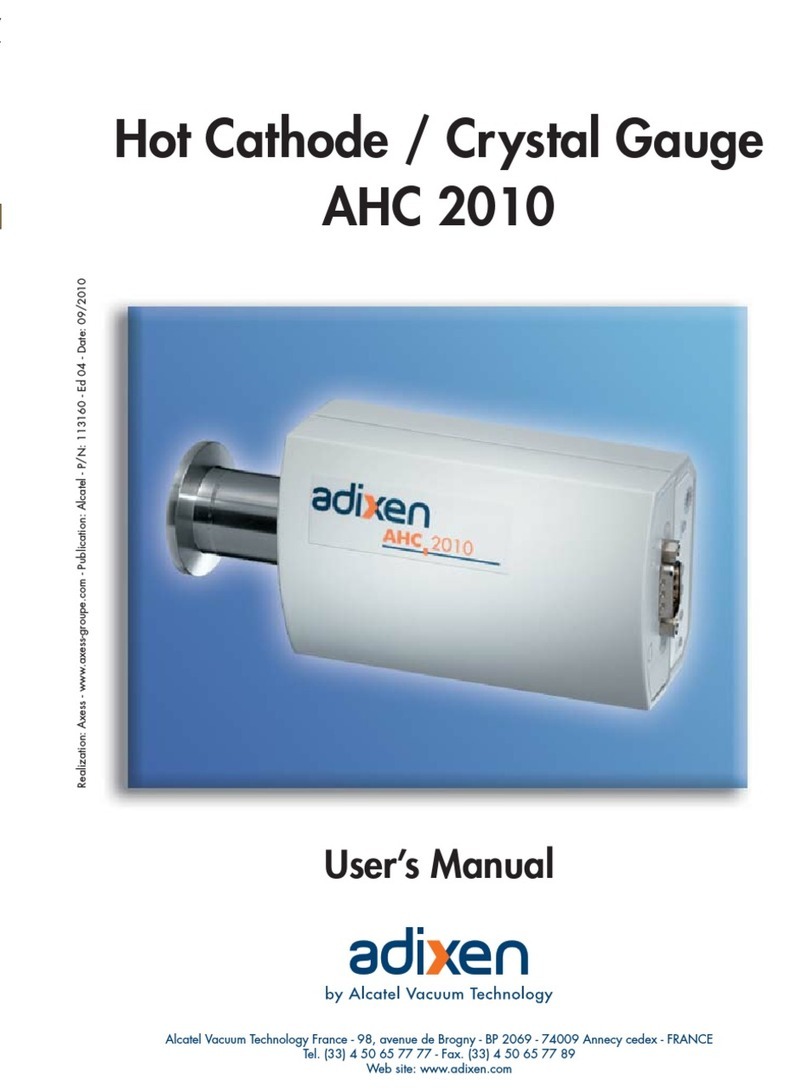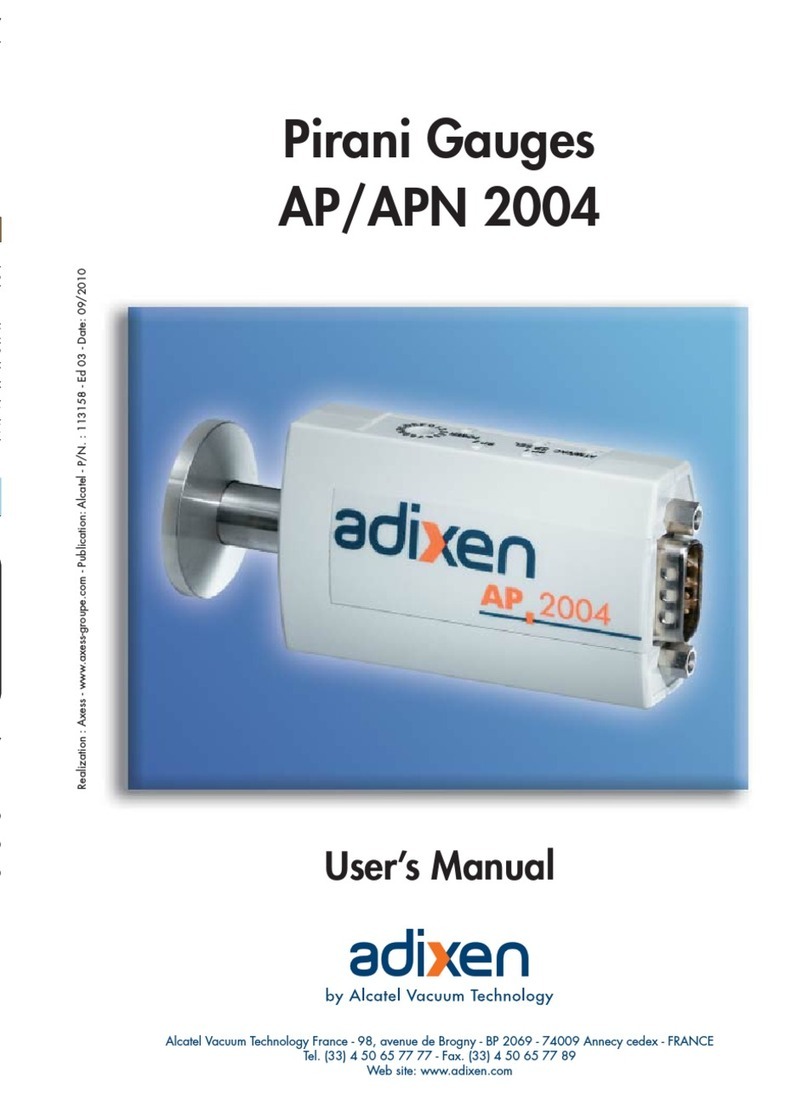
8/15Alcatel Vacuum Technology France - User’s Manual ACC 2009
12/15Alcatel Vacuum Technology France - User’s Manual ACC 2009
9/15Alcatel Vacuum Technology France - User’s Manual ACC 2009 10/15Alcatel Vacuum Technology France - User’s Manual ACC 2009 11/15Alcatel Vacuum Technology France - User’s Manual ACC 2009
13/15Alcatel Vacuum Technology France - User’s Manual ACC 2009 14/15Alcatel Vacuum Technology France - User’s Manual ACC 2009 15/15Alcatel Vacuum Technology France - User’s Manual ACC 2009
The analog output signal (0/10V) is available on Pins 1(+) and 8(–).
The analog signal can be converted to pressure according to the
formula:
P = 10(1.667x U–d) where : P= pressure, U= analog signal
voltage,
d= constant.
Measurement limits: 8.6 V = 1000 mbar and 1.8 V = 5x10–9 mbar
Analog Signal output
0/10 V
(ACC 2009 - 0/10 V + SP)
RS485 communication is available on the connector Pins 1(+)
and 8(–) .
Refer to the RS485 Communication Manual for details.
RS485 Signal output
(ACC 2009 - RS485 + SP)
The Pirani gauge can be adjusted at two points, atmospheric
pressure (ATM) and at the low pressure limit of the gauge (VAC).
The gauge automatically determines whether the conditions are at
atmosphere or under low pressure (zero). Before adjustment, the
gauge must be mounted in the same orientation and conditions
it will be used in. It must be held in these conditions for at least
10 minutes before proceeding.
To adjust the zero, be sure the gauge current pressure is below
1 x 10-4 mbar (7.6 x 10-5 Torr).
Adjustment of the
gauge readings
6- Operation (ctd)
Set points 1 and 2 are modified using the switch selector:
- To set up the mantissa, use the digits 1 to 9 directly.
- To set up the exponent value (from +6 to –9) use the values in
the table below:
- To set up the measurement units, use:
mbar= 2 , torr = 1 or Pascal = any other position.
Set Point set up
Switch
selector
ABCDEF 0123456789
Exponent +6 +5 +4 +3 +2 +1 0 –1 –-2 –3 –4 –5 –6 –7 –8 –9
6- Operation (ctd)
Set Point set up (ctd)
(ACC 2009 - 0/10 V + SP)
Follow this example to set up the set points (refer also to table
next page):
set point 1: 5x10+2 = 500 mbar
set point 2: 8x10–1 = 0.8 mbar
Example values
Note: For the ACC2009 - RS485 + SP models, the set points are modified only via the RS485
interface (refer to the RS485 Communication Manual).
Set point output
6- Operation (ctd)
8- Maintenance
- 1.5 mm and 3 mm hexagonal key wrenches
- Long-nose pliers; inside circlip pliers (18-60 mm); Ohmmeter.
Tools required
- The sensor and/or the electronics can be replaced. Proceed as
follows:
- Loosen the set screw without removing it (1)
- Pull out the sensor (2) as shown.
- Replace the sensor (2) or the electronic (3) as needed.
- Carefully align the holes in the electronics to the pins on the
sensor, then push the sensor into the electronics. Take care not to
bend the pins on the sensor. Secure the sensor to the electronics
with the set screw.
- Be sure to calibrate the sensor after assembly ( 6 p. 9).
11 - Declaration of Conformity
10 - Decontamination and Product
Recycling
8- Maintenance (ctd)
If it is necessary to check the Pirani filament of the Sensor,
proceed as follows:
- Remove the sensor from the electronics as described above
- Using an ohmmeter, check the filament resistance between the
pin of the Pirani sensor and its ground spring.
- If the measured value is out of this range, replace the sensor.
Checking the filament
Item Description P/N
2
Sensor DN25 ISO KF ACC 2009 113046
Sensor DN40 ISO KF ACC 2009 113047
Sensor DN40 CFF ACC 2009 113048
Maintenance kit ( 8 p. 13) 113042
Trigger kit 118808
3Electronics 0/10 V + SP ACC 2009 113039
Electronics RS485 + SP ACC 2009 113040
Products that are not clearly declared as “free of harmful substances“ are decontaminated
at the expense of the customer. Products not accompanied by a duly completed “Safety
Questionnaire“ are returned to the sender at his own expense.
In compliance with Directive 2002/96/CE concerning the handling
of electrical and electronic
equipment waste and Directive 2002/9/CE concerning restrictions on hazardous substances,
Adixen products that have reached the end of their service life must
be returned to the
manufacturer for decontamination and reuse. The manufacturer’s obligation to recover such
equipment applies only to complete items of equipment that have been neither modified nor
retrofitted and have used only spare parts from Alcatel Vacuum Technology sold by Alcatel
Vacuum Technology and including all their assemblies and sub-assemblies. This obligation
does not include the cost of transporting the product to a reprocessing centre, nor the cost of
the service which will be invoiced on to the customer. All equipment returned to the service
centre, must have a properly filled in safety questionnaire. The questionnaire is available
separately, or on our Web site.
Separating the components
After disassembling the product, separate its components according to the following criteria:
Contaminated components: Contaminated components (radioactive, toxic, caustic, or
biological hazard etc.) must be decontaminated in accordance with the relevant local
regulations, separated according to their materials, and disposed of.
Other components: Such components must be separated according to their materials and
recycled.
Unit Pa mbar Torr
d9.33 11.33 11.46
For use with gasses other than Air, O2, N2, or CO, multiply the pressure reading by the
conversion factor from the table below: This formula is useful only for pressures under 1 mbar.
Peffective = Pread x C
10–8
10–6
10–4
10–2
1
102
104
2.5 3.0 4.0 5.0 6.0 7.0 8.0 8.6
3.5 4.5 5.5 6.5 7.5 8.5
10–8
10–6
10–4
10–2
1
102
104
2.5 3.0 4.0 5.0 6.0 7.0 8.0 8.6
3.5 4.5 5.5 6.5 7.5 8.5
Pa
mbar
Torr
Pressure P
10–8
10–6
10–4
10–2
1
102
104
2.5 3.0 4.0 5.0 6.0 7.0 8.0 8.6
3.5 4.5 5.5 6.5 7.5 8.5
Measurement
signal U (V)
9- Returning the Products
Replacement procedure:
1-
Remove the sensor from the electronics
( 8 p. 12). 2-
Unscrew and remove the magnet
(1).
3-
Remove the 3 screws
(2)
and remove the items to be replaced
(3. 4-
Pull out the protection
screen
(4)
with a bent paperclip or similar tool, then remove the circlip
(4b)
with appropriate
circlip pliers, then slide out the disk
(4c). 5-
Clean the interior of the sensor, the screen, circlip
and disk with isopropol alcohol and lint free wipes, swabs and /or scrubbing pads. Do not
scratch the interior finish of the metal.
6-
Reassemble the sensor in the reverse order of dis-
assembly, replacing items with those supplied in the maintenance kit.
7-
If possible, test the
reassembled sensor for leaks
. 8-
Attach the gauge to a vacuum pump or vessel and evacuate for
one hour before calibrating the gauge ( 6 p. 9)
6- Operation (ctd)
Set
the dial
Validate
with the SP SEL
button
Check
the confirmation
SP1 SP2
Initial state
1Start the process
2Set the dial to ‘5’ for the
mantissa of set point 1 (5x10+2)
3Set the dial to ‘E’ for the exponent
of Set point 1 (5x10+2)
(+2 = ‘E’ from the previous table)
4Set the dial to ‘8’ for the
mantissa of set point 2 (8x10–1)
5
5) Set the dial to ‘1’ for the
exponent of set point 2 (8x10–1)
(-1 = ‘1’ from the previous table)
6Set the dial to ‘2’ for mbar
(1 = Torr, any other setting = Pascal)
– End of process –
LED off
LED on steady
LED flashing
The set point relay output has a fixed 10% hysteresis.
Pressure Signal
Off Off
On On
Set Point Value
Relay Output
Hysteresis
+ 10 % of S. P. value
When removing this gauge from the vacuum system, do not touch
the inside of the connecting flange of the gauge or vacuum system
with bare hands. Fingerprints will increase outgassing in the gauge
and cause erroneous pressure readings
- Vent the vacuum system to atmospheric pressure.
- Turn off the power to the gauge.
- Remove the electrical connector.
- Remove the gauge from the vacuum system.
- Place a protective cap on the fitting to prevent foreign
substances from entering the gauge.
- If the gauge must be stored, we advise to keep it away from
heat, moisture an dust ( 4 p. 4).
Parts on a vacuum processing system can be contaminated with
material that is detrimental to health and environment.
Before removing this gauge, confirm whether or not the gauge
is contaminated with any harmful gasses or vapors. If it is
contaminated with any harmful substances, be sure the gauge and
equipment are purged and cleaned thoroughly before removal of
the gauge.
Take the necessary precautions when handling contaminated parts,
refer to 9 p. 13.
7- Gauge Removal
Dirt and damages can impair the function of vacuum
components. Disregard can lead to an increase of out gassing in
the vacuum system and it may have negative effects on the vacuum
process itself. Keep the gauge clean.
Do not clean the measurement device except the connecting flange.
Only use denatured alcohol to clean the outside of the gauge.
Substances detrimental to the environment.
Products or parts thereof (mechanical and electriccomponents,
operating fluids etc.) can be detrimental to the environment. Dispose
of such substances in accordance with all relevant local regulations.
Contaminated parts
Contaminated parts can be detrimental to health and the
environment. Before working on any parts, find out if they are
contaminated. Adhere to any relevant regulations and take the
necessary precautions when handling contaminated parts.
There is no adjustment for the cold cathode gauge.
Note: For ACC2009 – RS485 + SP models, the adjustments can
also be donevia the RS485 interface.
Allow to restore the
ATM or VAC stored
value.
Press
and hold Release
time
green greenorange
ATM or VAC adjustments
Sub-assembly
replacement
57 Ω
1
3
2
The items required for maintenance of the sensor are available
in a kit.
Maintenance of the
sensor
Maintenance Kit P/N 113042
Triger Kit (3 triggers) P/N 118808
Item Description
3a Spring
3b Pirani gauge
3c JO-ring
3d Anode
3e O-ring
5Trigger
Contaminated products (e.g. with radioactive, toxic, caustic
or microbiological hazard) can be detrimental to health and the
environment. Products returned to the manufacturer should be
cleaned and free of harmful substances. Be sure to follow the
shipping regulations of all involved countries and forwarding
companies and enclose a duly completed «Safety Questionnaire»
available on our web site before shipping any products back to the
manufacturer.
Error catalog
Error Gauge ACC 2009
Power Led & Voltage (V)
Controller
Message Probable Error Action
AV 9,5 V red ErrHi Broken filament of Pirani Check Pirani filament
Replace sensor head
B* 8,582 ≤V < 9,5 V green Or If correct ATM/VAC
adjustment is not possible
or in case of erractic mea-
surements
=
sensor contaminated
Check sensor head
Replace sensor head
C* 2,199 V < 8,582 V green 1x2 +2
D* 0,5 V < 2,199 V green Ur
E0,2 V < 0,5 V red Err06 Electronic error Replace electronics
GV 0,2 V red ErrL0 Electronic error Replace electronics
(*) = minor errors degraded working of the gauge
Pressure
Gas H2H2O CCl2F2He CO2Air, O2
CO, N2
Ne Ar Kr Xe
10-3<P<1mbar C 0,5 0,5 0,7 0,8 0,9 1,0 1,4 1,7 2,4 3,0
< 10-5 mbar C 2,4 - - 5,9 - 1,0 4,1 0,8 0,5 0,4
4
3
2
1
4a
4b
4c
5
3c
3b
3a





























